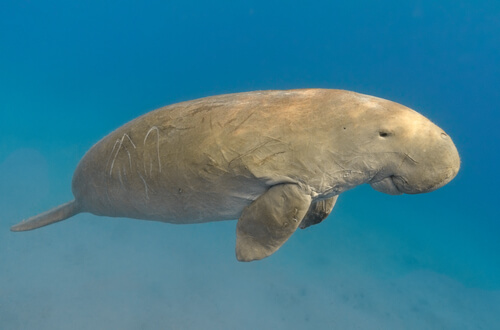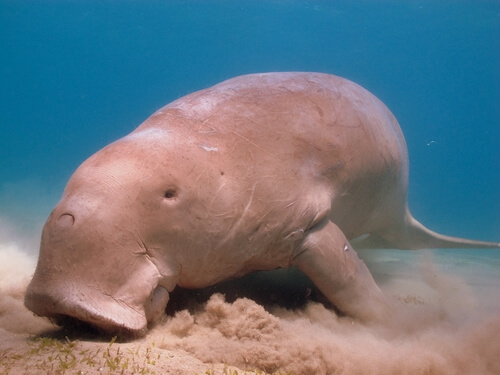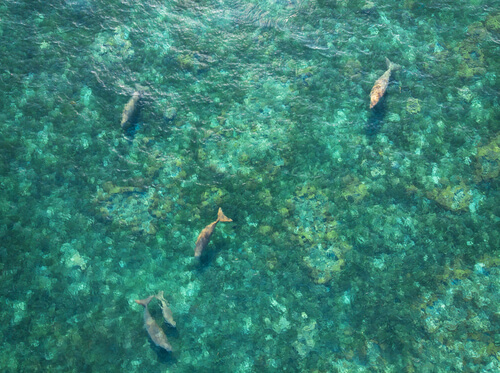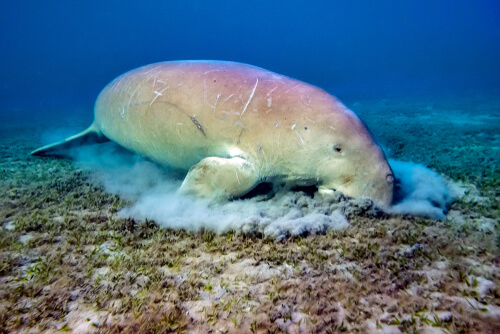
| Kingdom | Animalia |
| Phylum | Chordata |
| Class | Mammalia |
| Order | Sirenia |
| Family | Dugongidae |
| Genus | Dugong |
| Species | D. dugong |
| Niche | Herbivorous marine mammal |
| Length | 10 ft (3 m) |
| Weight | 926 lb (420 kg) |
| Lifespan | 70+ years |
| Social Structure | Social, but often solitary or in pairs due to dwindling seagrass |
| Conservation Status | Vulnerable |
| Preferred Habitat | Seagrass beds in shallow marine waters |
| Number of Offspring | 1 |
| Main Diet Species | Seagrass |
| Predators | Humans, crocodiles, orcas, sharks |
The Basics
The dugong is a marine mammal that spends its time grazing on seagrass in shallow coastal waters. A close relative of manatees, it is the only remaining member of the Dugongidae family. Often dubbed ‘sea cows’, dugongs are the only marine mammal that eats virtually only plants.

Dugongs have a long, cylindrical body and no dorsal fins. They have a fluked dolphin-like tail that they use to swim and small flippers as fore-limbs that they use to turn and slow down. Their skin is thick and smooth and sparsely covered in short hairs. It is generally a pale cream color when young, darkening to brownish or grey as they grow to adults depending on the specific algae on their skin. They have ears on the side of their head and nostrils located on the top. Their mouth is on the bottom of their head and features a large horseshoe-shaped upper lip forming part of a muzzle. This large, strong lip aids in foraging. While feeding, they will remain underwater for up to 6 minutes without a fresh breath of air.

Males boast two incisor tusks when they reach sexual maturity, generally around 8-18 years old. Females also have tusks but they do not typically emerge from their mouths at puberty, but sometimes later in life. Dugongs are long-lived, with the oldest recorded specimen having reached the age of 73.
A Shrinking Range
Dugongs are found in the waters of the West Pacific across nearly 40 countries and 57,000 miles of coastline. The largest populations are found in wide, shallow, protected coastal areas such as estuaries, bays, and mangroves. One of the strongest populations exists in northern Australia.

Due to hunting, habitat destruction, and fishing-related casualties, dugong populations are thought to be shrinking. They are listed as vulnerable by the IUCN and have already disappeared from areas such as Hong Kong, Mauritius, Taiwan, and other parts of Asia.
Fun Facts about Dugongs!
Humans and dugongs have been interacting for thousands of years, primarily because they are easy targets for hunting. There is a painting of a dugong drawn by neolithic peoples in a cave in Malaysia that dates back some 5,000 years. In fact, dugongs may be the inspiration for myths of sirens and mermaids!
Dugong vs. Manatee
Dugongs are easily distinguished from manatee species by their dolphin-like tail, whereas manatees have hind fins more similar to a seal or walrus. They also have other specific adaptations such as a down-turned snout that allow it to feed specifically on seagrass with its unique, peg-like molar teeth.
Slow-moving and Slow-growing
Much like they move, dugongs also grow slowly. Females give birth to just one calf after a year-long pregnancy. Her young will remain close to her for up to 18 months. Because of their long life span (70 years) and slow reproduction rates, dugong populations are vulnerable despite legal protection. Humans have hunted dugongs for thousands of years, primarily for its meat and oil.

Also, their seagrass habitat is fragmented and sensitive, leaving dugong populations that feed on them vulnerable as well. In order for populations to be sustained, only 1-2% can be lost to these human-caused threats. Indeed, many individual populations are believed to be approaching extinction.
Using Hair to See
Dugongs have poor eyesight but good hearing. They are also covered head to tail with short hairs. These hairs are most concentrated around the mouth and are thought to help them navigate the seagrass beds, much like dogs and cats use their whiskers as a navigational aid.
Big Boned
Dugong bones have almost no bone marrow inside and are very solid. In fact, dugong bones are among the densest in the entire animal kingdom. These may act as a type of ballast, allowing the animal to remain effortlessly suspended just below the surface of the water when resting. Sometimes, they will rest their tail on the bottom to anchor themselves in place while sleeping or resting with just part of their head above the surface to breathe.
Silent Predators
Although adult dugongs have few predators due to their size, they are quite susceptible to pathogens including helminths, cryptosporidium, and other bacterial and parasitic infections. In fact, in Queensland, Australia, up to 30% of dugong deaths are due to disease. Even still, the biggest threat to dugongs is habitat loss and death at the hands of humans.
